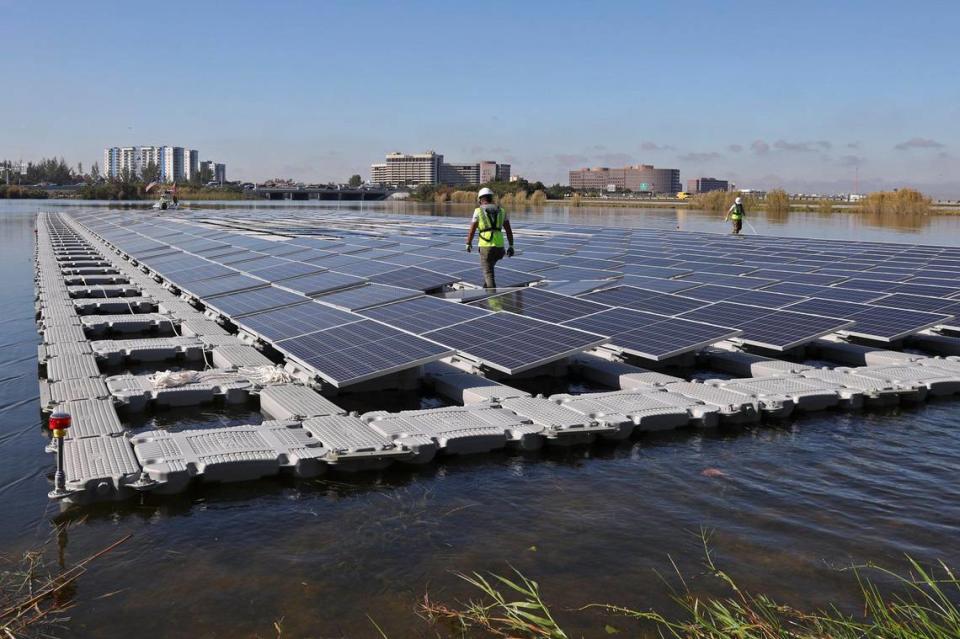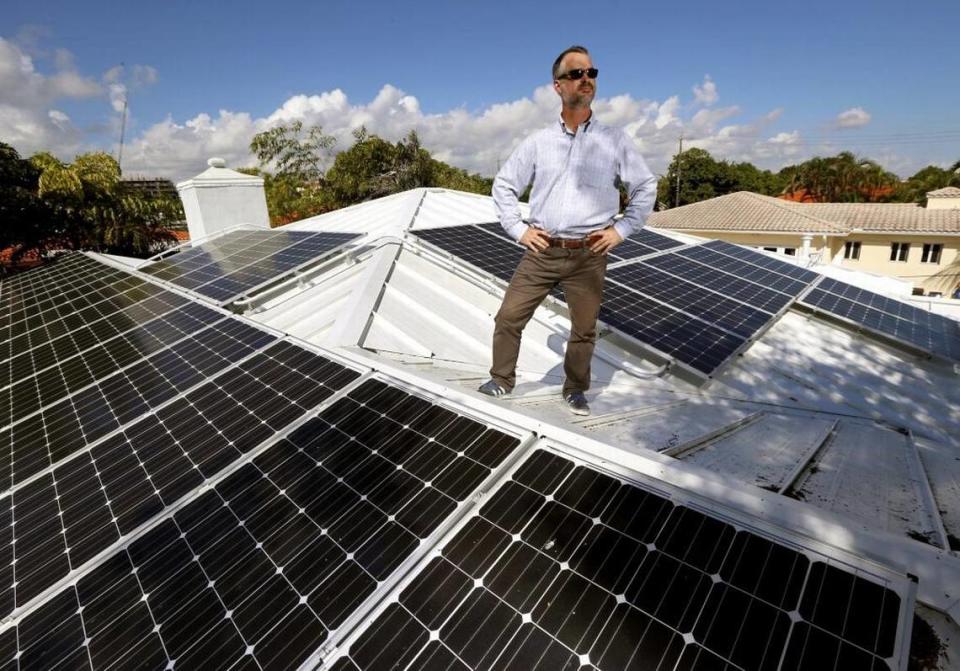Sunshine State solar slowdown: Installers scrambling for panels, big projects delayed
Florida solar installers are scrambling for panels amid a nationwide market slowdown, and some are turning to older, less efficient models to get the job done.
The utility with the nation’s biggest solar and wind investments, NextEra Energy, said up to three-quarters of its 2022 solar projects could be delayed until at least next year. The CEO of its subsidiary, Florida Power & Light, said the utility can’t find anyone in the U.S. willing to sell them more panels.
In a state-by-state survey by a solar trade group, 84% of Florida solar companies surveyed reported cancellations or delays in their supply of solar panel parts.
And in the biggest sign of market chaos, Orlando’s two newest solar farms were delayed a full year, to 2024, and negotiations for the associated battery project were paused indefinitely.
The reason for the solar power delays and confusion in Florida and across the nation: An ongoing federal investigation into whether China was evading U.S. trade restrictions — and costly tariffs — by selling cheap panels through companies from other Southeast Asian countries. Some of the Asian companies targeted by the investigation have since slowed down or stopped importing to the U.S. over fears of hefty retroactive tariffs, causing nationwide shortages and price spikes.
“We were in the middle of negotiations when these challenges popped up,” Jan Aspuru, chief operating officer of Orlando’s utility, told the Orlando City Commission. “We will continue having discussions with our partner, NextEra, on the price impacts to these solar projects.”

The solar trade group survey estimated that shortages and the uncertainty surrounding the investigation puts $850 million of solar investment in Florida at risk. Industry executives also warned that delays could jeopardize the United States’ shot at meeting its climate goals and averting the worst impacts of climate change.
Last week, 75 members of Congress (including Florida Democrats Debbie Wasserman Schultz, Charlie Crist and Kathy Castor) wrote a letter to President Joe Biden urging him to quickly conclude a federal investigation due to the “severe negative consequences” on the solar industry.
But some trade groups argue that the investigation by the Department of Commerce is important to protect another growing part of the solar industry — American producers of panels, who struggle to compete with cheap imports.
Eric Silagy, CEO of Florida Power and Light, the state’s largest utility, said on a panel at Aspen Ideas Climate in Miami Beach in early May that the investigation has led to layoffs and delays nationwide.
“If we don’t address this quickly there will be a knock-on effect that will last for years. This is not something you can restart with a snap of the fingers,” he said. “I can’t just get manufacturers. There are none in the United States that have panels available. We’ve gone to everybody that does and said we’ll buy anything you have. Give it to us. They say we don’t have any panels available.”
Shortages and delays in Florida
The solar shortage comes right off a recent win for the Florida rooftop solar industry, the governor’s veto of a bill that would have made rooftop solar more expensive for homes and businesses.
Justin Vandenbroeck, president of Florida Solar Energy Industries Association (SEIA), a trade group that represents more than 100 manufacturers, solar contractors and financiers in Florida, said he calls the uncertain ups and downs of the industry “the solar coaster.”
“It’s just tough. We feel like we just got this major win with the veto of the net metering bill and now this. We can’t catch a break,” he said. “Between inflation and now supply shortages a lot of contractors are now feeling the pain.”
Citing cost pressures on homeowners, DeSantis vetoes bill to end solar incentives
Vandenbroeck advised his members to be “resourceful” and fill the gaps with solar panels that were manufactured a few years back and not sold, even though they’re not as efficient.
He also owns his own solar installation company, and he’s had to delay a project to install solar on an AdventHealth facility in Central Florida because he couldn’t get the materials he needed.
South Florida-based Goldin Solar, which installs rooftop solar on homes, is also feeling the pinch. CEO Daren Goldin said he’s seen a 20% to 30% spike in costs for solar panels.
“We have panel manufacturers that we work with that are actually raising their panel prices not because they were hit with tariffs but because they’re hedging against the possibility of retroactive tariffs,” he said.
In response, Goldin said he’s had to adjust his contracts and ask clients to pay more up front, rather than wait until a permit is approved.
But not everyone is reporting issues, at least yet.
South Florida’s Solar United Neighbors, a solar co-operative that helps homeowners and businesses join together for more affordable solar, said it’s seen less disruption since most of their clients are using smaller arrays that are more likely to be produced in the U.S.
Heaven Campbell, Florida program director for SUN, said she hasn’t seen any delays or canceled projects yet.
“We hope that this goes away very quickly and there’s some more clarity very quickly,” she said.
For FPL, the concerns so far apply to future work, not 2022 projects, which are already completed, said David Reuter, chief communications officer for FPL. “At this point, we’re working really closely with the suppliers… to ensure that there’s minimal if no disruption, particularly as it pertains to our Florida build-out,” he said.
Reuter said FPL has seen impacts in its energy resources division, which provides large-scale installations for companies and communities but declined to detail any specific instances.
Are solar producers breaking the rules?
The disruption began in March, when a small California-based solar panel manufacturer, Axum Solar, asked the Department of Commerce to investigate the possibility that manufacturers in the four countries that make up 80% of U.S. solar imports — Malaysia, Cambodia, Vietnam and Thailand — were skirting the U.S. duties by serving as a “pass-through” for Chinese solar panels.
The Commerce Department opened an investigation later that month, generating a jolt of uncertainty over costs and supplies for the solar industry.
The U.S. government has long had trade concerns about panels from China. The Chinese government deeply subsidizes the solar panels it manufactures, allowing it to flood the market with products that undercut other makers. Some Chinese solar companies have also been blacklisted by the U.S. over allegations of slave labor. In response, the Obama administration levied duties on Chinese panels, which the Trump and Biden administration both renewed.
“There’s no doubt that the mere initiation of the investigation, just in the first month, has had an extremely negative impact on the solar industry across the country,” said Reuter, from FPL.

If the investigation, scheduled to conclude in late August, finds any wrongdoing — solar importers could get smacked with retroactive tariffs on anything shipped since the start of the investigation. They cover the price of the components and range from 12% to 250%.
Lori Wallach, the director of the ReThink Trade program at the American Economic Liberties Project, a group that supports the investigation, believes the actual financial threat is limited and the industry reaction overblown. She said only a few importers have ever been hit with tariffs as high as 100% or 200%, and they were wholly owned and operated by the Chinese government. She argued that the tariffs work exactly as intended, and any new ones from the investigation would help the domestic market.
“It’s basically just taking the thumb off the scale for domestic producers,” she said. “If you are a company with a 220% tariff, we want to price you out of the market.”
Wallach also questioned why producers who knew they weren’t doing anything wrong would be afraid of the tariffs, which have been in place for a decade.
But some sections of the solar industry, especially groups representing installers that rely on cheap panels to turn a profit, said the fear of those retroactive tariffs has scared suppliers into selling their goods to other countries instead of the U.S., slowing down or stopping the supply of panels.
The Solar Energy Industries Association, an industry lobby group that also represents U.S. subsidiaries of some of the companies targeted in the investigation, said internal surveys of its members show solar installation forecasts for this and next year are down by nearly half, thanks to the investigation and pandemic supply chain issues.
Abigail Ross Hopper, chief executive of SEIA, wants to see the Department of Commerce end the investigation early. She pointed to the department’s multiple previous investigations into the Chinese solar dumping question, all of which concluded that nothing was amiss.
“These are all questions that have been asked and answered by the department before on four different occasions,” she said. “We think the evidence determines they should reach a negative conclusion.”
Building up domestic supply
One of the main reasons for the solar freeze in the U.S. is the state of the domestic solar panel manufacturing industry. It’s way too small, experts say.
“We all want there to be a larger domestic source of solar panels that we can buy from but the reality is that industry has not changed significantly in the last five years,” said Reuter, from FPL. “The domestic industry in the U.S. can supply about 20% of U.S. demand for panels.”
FPL has a leg up on other utilities in that regard because it has an agreement with one of the few companies that does some domestic manufacturing — China-based JinkoSolar, which has a plant in Jacksonville. JinkoSolar, one of the largest solar producers in the world, is one of the companies under investigation.

On his panel last week, FPL’s Silagy said he was instrumental in convincing Jinko to open in Florida.
“We bought every panel that they manufactured, the entire output of the plant, which is why they moved here initially,” he said. “But unfortunately for them, the cost structure is still more expensive than any other facility they have in their global supply chain.”
Florida is also home to another solar manufacturing site in Riviera Beach, owned by Canadian-based Heliene. Neither Jinko not Heliene responded to requests for comment.
Hopper, from SEIA, also took issue with the idea that the Department of Commerce’s investigation would boost domestic production.
But one thing she and the groups supporting the investigation can agree on is what else could help: a suite of tax credits and incentives for domestic producers. The bill already passed the House of Representatives as part of the Biden administration’s Build Back Better act, but it’s stuck in the Senate.
“It’s a much more stable and much more reliable way to bring more manufacturing to the U.S.,” she said. “You can’t just snap your fingers and overnight spawn a domestic industry.”

